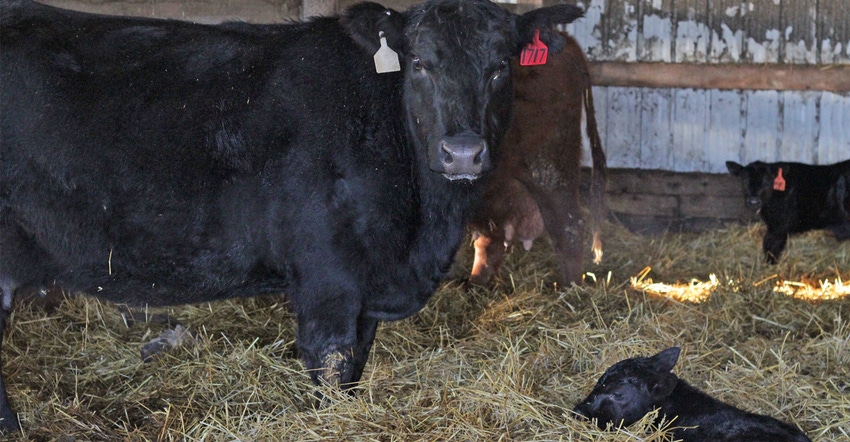Manage for nutrition, cold temperatures and disease to maintain herd health.

With winter being the start of calving season for many ranchers in the Dakotas, prepare now to start calves off on the right foot and ensure a healthy cow herd.
Olivia Amundson, cow-calf field specialist at South Dakota State University Extension, says nutrition plays a major role in the health and success of calving.
“Overfed or overconditioned cows have the potential to struggle with dystocia due to the accumulation of fat in the pelvis, which hinders the fetal passage through the birth canal,” she says.
Young heifers and cows must be carefully managed to ensure they are receiving the correct nutrition throughout their gestation. “Two-year-old heifers and 3-year-old cows are the most vulnerable to nutritional needs during the last trimester, due to continual growth of the dam and the calf in utero. It is important to make sure these females are receiving adequate protein and energy during times of cold weather,” Amundson says.
Veterinarian Russ Daly, with SDSU Extension, says producers who understand when assistance is needed during calving will be better prepared to minimize unnecessary cow losses this season. “Producers should examine a cow to determine the cause of dystocia if a cow has been in Stage 1 labor for more than eight hours, the cow has been trying but stops during delivery for more than 15 minutes, the cow has been trying for over 30 minutes with no progress, or if there are signs of distress present in the fetus or the cow,” he says.
Signs of distress during the birth include:
swollen tongue or head of calf
fetal membrane appears before the calf
severe bleeding from the rectum or birth canal of the cow
backward calf delivery
Daly says the vast majority of calving occurs without complications. “When problems do occur, cattle producers can minimize adverse effects on both the cow and calf by having a thorough understanding of the stages of labor and how to respond to difficult situation.” Find more information on the stages of labor at SDSU Extension.
Calf health and colostrum
Calves need about 2 quarts of colostrum within four hours after they are born, and a gallon within 12 hours. This colostrum is high in nutrients and antibodies, and is critical for the health of the calf.
“The most efficient way to provide initial colostrum to the calf is through suckling the dam,” Amundson says. “If the calf is unable, then other methods need to be considered.”
Frozen colostrum can be acquired from healthy cows, or a replacer can be used if there is no access to fresh colostrum.
Health problems that can be encountered by calves include:
diarrheal diseases
septicemia
respiratory disease
naval infections
frostbite
“Newborn calves are perhaps the most fragile subset of animals present in the cow-calf operations,” Daly says. “Producer can help reduce this vulnerability by reducing exposure to disease-causing organisms and managing exposure to weather conditions.”
Due to the ability of bacteria-borne diseases to impact calf health, a solid understanding to keeping calves safe from disease-causing bacteria is crucial. Many of these diseases can be avoided by keeping a clean environment for newborn calves. “Exposure to enough of these organisms can overwhelm a calf’s immune system and is the root cause of diarrheal illness in baby calves,” he says. Taking steps to reduce the buildup of these organisms in calving areas is imperative to preventing diarrheal disease.
Winter weather
Keeping calves warm if they are born during frigid conditions is critical. Daly says that hypothermia is a common cause of death in calves born in cold conditions. “Efforts to warm a chilled calf should not be delayed, and can incorporate a variety of methods including a warming crate, hot box, blankets and immersion in warm water,” he says.
Many producers in the Northern Plains utilize calving barns or sheds to help soften the blow of winter weather on newborn calves. With frostbite being one way calves can be affected, Daly says producers can take steps to prevent this. “The first signs on frostbite can manifest itself as stiffness to the ears, tail and rear feet.”
If frostbite is caught soon enough, damaged tissue can possibly be saved. In the case of ears and tail, frostbite damage is mostly cosmetic, but frostbite damage to the rear legs should be the time that welfare concerns are brought into consideration.
Julie Walker, SDSU Extension beef specialist, says there are practices to reduce effects of winter weather on cattle. Providing wind protection in either temporary or permanent structures, and providing bedding materials to insulate from the freezing ground and keep animals dry.
“Because wind exerts such a large influence on an animal’s thermal environment, management adaptions and animal behavior responses tend to address the effects of wind as a way to mitigate the impact of cold stress,” she says. “Reducing the amount of heat losses requires some investment or modifications to the environment of the animal, with the benefit of lowering the animal’s maintenance energy requirements.”
More information on this and other beef topics can be found in the Beef: Best management practices for cow-calf production publication from SDSU Extension.
About the Author(s)
You May Also Like





